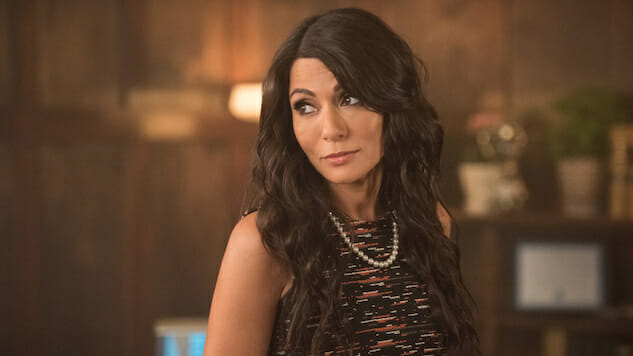At the heart of Riverdale is, well, Riverdale. For all its vaguely futuristic, neon-lit scenery and its abundance of absurdly attractive citizens, Riverdale is its own organism, even its own character. Yes, it’s a cliché at this point to note that a place in a work of fiction is a character in and of itself, but it’s also important to point out when it comes to Riverdale, because the history of Riverdale is necessary context for everything that’s happening. More than in any previous episode, “Chapter Four: The Last Picture Show” uses the setting to enhance the mysteries and secrets of nearly every resident.
Riverdale has no shortage of these mysteries and secrets, and one reason “The Last Picture Show” isn’t on the same level as last week’s episode is the overload of information. There’s a lot going on here: Ms. Grundy’s (Sarah Habel) affair with Archie (K.J. Apa) is exposed, first to Betty (Lili Reinhart) then to Alice (Mädchen Amick) and Fred (Luke Perry); we learn that Jughead (Cole Sprouse) is homeless and that his father, a member of the Southside Serpents biker gang, is in collusion with the Lodge family; and it’s revealed that “Grundy” is the assumed name of Jennifer Gibson, who moved to Riverdale to escape an abusive marriage (assuming she’s telling the truth). That’s a lot to unpack in a single episode, and there are times when “The Last Picture Show” feels bogged down by the need to delivering these tidbits of information. At the same time, the episode uses a single storyline to keeps things grounded, and that’s a credit to the series’ steady hand so far this season.
That single storyline is the closing of Riverdale’s historic Twilight Drive-In Theater. It’s exactly the kind of story you’d expect a show about a small town to tell, and there’s no denying that there’s an air of authenticity to it; the feeling of disillusionment spurred on by the decaying of cultural institutions and the brick-and-mortar buildings that house them is certainly a resonant one, making the out-of-time Riverdale feel a little more like small-town America. That’s an important grounding, because it not only balances out Riverdale’s more over-the-top tendencies—it also drives home one of the series’ main themes, which is that, while we tend to lament the death of certain small town ideologies and ways of life, we forget to examine the people who make that happen.
In essence, “The Last Picture Show” uses the closing of the Twilight to expose the corruption that’s always been part of Riverdale’s fabric. Jughead, Alice and many others can opine about how Riverdale has lost its way, giving the town a sentience of sorts, but what they’re missing is that the people of Riverdale are the responsible party. The town, for all of its unique characteristics, is a product of its people, and tonight’s episode suggests that those people aren’t as innocent in the demise of their town as they purport to be.
Take Hermione Lodge (Marisol Nichols), for instance. It would seem she’s been making a new life for herself and her daughter, Veronica (Camila Mendes), finding respite in Riverdale while hitting back at the snide comments of people like Cheryl Blossom (Madelaine Petsch). “The Last Picture Show” paints her in a different light, as she’s seen doing her husband’s dirty work, using the Southside Serpents to destroy the value of the Twilight so that Lodge Industries can anonymously buy up the land. It’s a fascinating web of secrets and motivations, but even more intriguingly, it takes the question at the heart of Jason Blossom’s murder—who’s innocent?—and redirects it toward the town’s degradation. “The Last Picture Show” moves the series away from the murder mystery in order to flesh out Riverdale itself, excavating the lives of its people and exposing the rot. In essence, the murder of Jason Blossom is a very real, grisly manifestation of Riverdale’s failing institutions.
“The Last Picture Show” does a remarkable job implicating nearly everyone in the town’s demise. Hermione’s shady dealings are the most obvious example, but Grundy’s uncertain past and unclear motivations are evidence as well. It’s no accident that Grundy’s heart-shaped sunglasses evoke Lolita, a novel that explores moral ambiguity and the complexity of sexual desire. (Lolita also employs a motif of doubles, and Archie sure does look a lot like Jason Blossom—but let’s save that tangent for a future episode, because something tells me that the series’ hasn’t even come close to fully drawing the connection between Archie and the his former classmate.) It’s also no accident that the episode’s title is the same as Peter Bogdanovich’s 1971 coming-of-age film about kids growing up in a small town that’s economically and culturally deprived.
In one sense, “The Last Picture Show” doesn’t move the plot along, as we don’t get any closer to knowing who killed Jason. But that doesn’t mean it’s stagnant. Instead, it’s laser-focused, using the destruction of a Riverdale landmark to tell a variety of stories about moral and cultural decay, personal compromise, and the limits of loyalty, all wrapped up in the show’s acute portrayal of teen angst. It’s a beautiful thing to witness such nimble storytelling.
Kyle Fowle is a TV critic whose work has appeared at The A.V. Club, Entertainment Weekly
and Esquire
. You can always find him tweeting about TV and pro wrestling @kylefowle.
